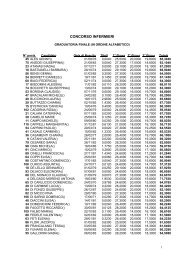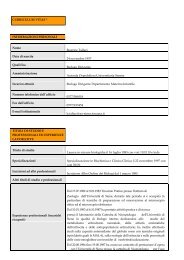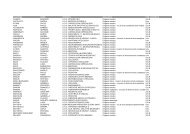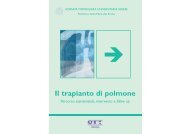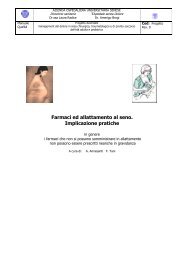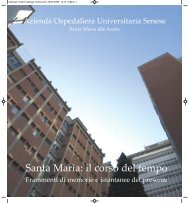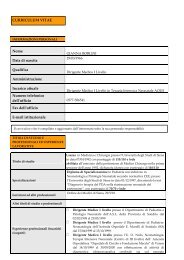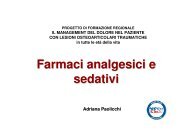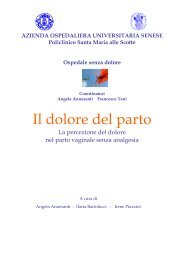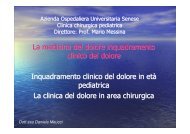malaria
malaria
malaria
You also want an ePaper? Increase the reach of your titles
YUMPU automatically turns print PDFs into web optimized ePapers that Google loves.
MALARIA<br />
Federico Gobbi<br />
Centro per le Malattie Tropicali, Negrar VR
LA MALARIA<br />
La <strong>malaria</strong> è la malattia protozoaria<br />
trasmessa da vettore più diffusa al mondo<br />
• è endemica in > 90 paesi<br />
• 300-500 milioni di casi/anno<br />
• 2 milioni di decessi/anno<br />
• principale causa di mortalità<br />
VETTORE<br />
AMBIENTE<br />
OSPITE PARASSITA
Anopheles
VECTORS SURVIVING<br />
SPOROGONY (%)<br />
EFFETTO della TEMPERATURA sulla<br />
TRASMISSIONE<br />
40<br />
35<br />
30<br />
25<br />
20<br />
15<br />
10<br />
5<br />
0<br />
16 20 24 28 32 36 40<br />
TEMPERATURE (°C)
Livelli di Endemicità Malarica<br />
(Metselaar & Van Thiel, 1959)<br />
Tasso Parassitario<br />
IPOENDEMICA 0 – 10%<br />
MESOENDEMICA 10 – 50%<br />
IPERENDEMICA 50 – 75%<br />
OLOENDEMICA > 75%
Sono 4 le specie di Plasmodium<br />
sp. che determinano la malattia<br />
nell’uomo:<br />
1) Plasmodium falciparum<br />
2) Plasmodium vivax<br />
3) Plasmodium ovale<br />
4) Plasmodium <strong>malaria</strong>e
Sono 5 le specie di Plasmodium che<br />
determinano la malattia nell’uomo:<br />
1) Plasmodium falciparum<br />
2) Plasmodium vivax<br />
3) Plasmodium ovale<br />
4) Plasmodium <strong>malaria</strong>e<br />
5) Plasmodium knowlesi
0,3%<br />
7,7%<br />
N. percentuale di notifiche<br />
per regione dei casi di <strong>malaria</strong><br />
importati in Italia dal 2002-06<br />
(esame di 3354 schede)<br />
1,7%<br />
0,4%<br />
30,0%<br />
1,5%<br />
12,7%<br />
5,7%<br />
20,0%<br />
1,3%<br />
7,3%<br />
0,4%<br />
2,0%<br />
0,5%<br />
0,3%<br />
0,2%<br />
0,5%<br />
0,06%<br />
1,3%<br />
0,2%
GeoSentinel: Risk Ratio of Acquiring<br />
Travelers-VFR<br />
Travelers-<br />
Mission/Vol<br />
Travelers-Res/Ed<br />
Travelers-<br />
Business<br />
Travelers-<br />
Tourism*<br />
Malaria by Purpose of Travel<br />
0 2 4 6 8 10<br />
* Reference group RR/100 pt. encounters
Casi di <strong>malaria</strong> in Italia e nel Veneto – Anni 1993-2006*<br />
1200<br />
1000<br />
800<br />
600<br />
400<br />
200<br />
0<br />
Italia<br />
Veneto<br />
1993 1994 1995 1996 1997 1998 1999 2000 2001 2002 2003 2004 2005 2006<br />
*Napoletano G. et al., GIMT 2008
Casi di <strong>malaria</strong> in italiani e stranieri in Veneto - Anni 1993-2006<br />
200<br />
180<br />
160<br />
140<br />
120<br />
100<br />
80<br />
60<br />
40<br />
20<br />
0<br />
83<br />
1993<br />
54<br />
117<br />
111112<br />
107<br />
111<br />
101<br />
86 88<br />
91<br />
1994<br />
1995<br />
1996<br />
1997<br />
1998<br />
168<br />
188<br />
148<br />
79 80 78<br />
1999<br />
*Napoletano G. et al., GIMT 2008<br />
2000<br />
2001<br />
158<br />
55<br />
2002<br />
115<br />
70<br />
2003<br />
103<br />
50<br />
2004<br />
105<br />
54<br />
2005<br />
100<br />
Italiani<br />
Stranieri<br />
59<br />
2006<br />
110
Dati Verona – Negrar 2000-2004
NUMERO DI CASI<br />
• 340 CASI DI MALARIA<br />
• 44 CASI IN ETÀ PEDIATRICA<br />
120<br />
100<br />
80<br />
60<br />
40<br />
20<br />
0<br />
83<br />
102<br />
69 68<br />
2000 2001 2002 2003 2004<br />
58<br />
19
Distribuzione dei casi <strong>malaria</strong> di<br />
importazione negli anni<br />
Casi notificati in<br />
Italia (ISS)<br />
Casi Verona %<br />
2000 985 83 8,42<br />
2001 984 102 10,4<br />
2002 736 69 9,4<br />
2003 672 68 10,1<br />
2004 659 58 8,8<br />
totale 4036 380 9,4
number of cases<br />
100<br />
90<br />
80<br />
70<br />
60<br />
50<br />
40<br />
30<br />
20<br />
10<br />
0<br />
>15 15-24 25-34 35-44 45-54 55-80<br />
age groups<br />
severe<br />
uncomplicated
78%<br />
DIAGNOSI DI SPECIE<br />
9%<br />
5%<br />
2%<br />
6%<br />
FORME<br />
MISTE<br />
1%<br />
3%<br />
P.falciparum P.ovale<br />
P.vivax P.<strong>malaria</strong>e<br />
1%<br />
1%<br />
P.falciparum-P.<strong>malaria</strong>e P.falciparum-P.ovale<br />
P.ovale-P.vivax P.falciparum-P.vivax<br />
22
Febbre<br />
+<br />
viaggio in zona a rischio<br />
STRISCIO E GOCCIA SPESSA
SINTOMI<br />
febbre<br />
cefalea<br />
nausea<br />
vomito<br />
diarrea<br />
mialgie<br />
prostrazione<br />
Attacco acuto <strong>malaria</strong><br />
SEGNI<br />
splenomegalia<br />
ittero<br />
pallore
Attacco acuto <strong>malaria</strong><br />
REPERTI DI LABORATORIO<br />
piastrinopenia<br />
anemia<br />
aumento transaminasi<br />
aumento bilirubina
Criteri per definire la <strong>malaria</strong> grave e<br />
CLINICA<br />
• prostrazione<br />
• coma<br />
• distress respiratorio<br />
• edema polmonare<br />
• convulsioni<br />
• shock<br />
• ittero<br />
• CID<br />
• blackwater fever<br />
complicata<br />
TEST LABORATORIO<br />
• anemia grave<br />
• trombocitopenia<br />
• ipoglicemia<br />
• sepsi<br />
• acidosi<br />
• insuff. renale<br />
• iperparassitemia
MALARIA GRAVE:<br />
1. Malaria cerebrale<br />
Definizione:<br />
• Coma non risvegliabile:<br />
< 9 secondo il GCS<br />
(Glasgow Coma Scale)<br />
• Esclusione di altre<br />
encefalopatie (meningiti<br />
batteriche e virali)<br />
• Presenza di forme<br />
asessuate di P.<br />
falciparum su sangue<br />
periferico<br />
• In caso di morte:<br />
capillari occlusi da<br />
emazie parassitate<br />
contenenti pigmento<br />
G<br />
L<br />
A<br />
S<br />
G<br />
O<br />
W<br />
C<br />
O<br />
M<br />
A<br />
S<br />
C<br />
A<br />
L<br />
E<br />
APERTURA DEGLI OCCHI<br />
Spontanea 4<br />
A comando 3<br />
Al dolore 2<br />
Assente 1<br />
RISPOSTA VERBALE<br />
Orientata 5<br />
Confusa 4<br />
Parole inappropriate 3<br />
Suoni incomprensibili 2<br />
Assente 1<br />
RISPOSTA MOTORIA<br />
Obbedisce ai comandi 5<br />
Localizza il dolore 4<br />
Reazione in flessione 3<br />
Reazione in estensione 2<br />
Assente 1<br />
Totale GCS: 3-14
P-selectin<br />
ERITROCITA PARASSITATO<br />
HS<br />
CLAG<br />
Modified<br />
Band 3<br />
CSA<br />
TM<br />
TSA<br />
KAHRP<br />
<br />
Pf EMP3<br />
CD36<br />
ICAM 1<br />
Rifin<br />
Sequestrin3<br />
CELLULA ENDOTELIALE<br />
PECAM 1 VCAM 1<br />
E-selectin<br />
HA
Diagnosi<br />
1. Sospetto (anamnesi)<br />
2. Esame obiettivo (epato-splenomegalia, ittero, pallore)<br />
3. Goccia spessa (valutazione quantitativa; <strong>malaria</strong> grave ><br />
2% di GR parassitati)<br />
4. Striscio sottile (diagnosi di specie)<br />
5. Parasight (metodo immuno-cromatografico)<br />
6. Esami di laboratorio (emocromo, LDH, AST, ALT, CK,<br />
azotemia, creatininemia, glicemia, EGA, lattato)
STRISCIO E GOCCIA SPESSA
ANTIGEN MALARIAL TEST
Valutazione parassitemia<br />
con la goccia spessa<br />
+<br />
++<br />
+++<br />
++++<br />
1-10 par/100 CM<br />
11-100 par/100 CM<br />
1-10 par/CM<br />
> 10 par/CM
QUANTITATIVE BUFFY COAT
QUANTITATIVE BUFFY COAT
QUANTITATIVE BUFFY COAT
QUANTITATIVE BUFFY COAT
QUANTITATIVE BUFFY COAT
QUANTITATIVE BUFFY COAT
QUANTITATIVE BUFFY COAT
QUANTITATIVE BUFFY COAT
In zona endemica….<br />
Il neonato è parzialmente protetto dalla<br />
<strong>malaria</strong> grazie agli anticorpi materni ed<br />
all’emoglobina fetale<br />
La durata di tale protezione è stimata<br />
intorno ai 6 mesi dalla nascita<br />
Nel periodo successivo inizia una fase<br />
di piena suscettibilità alla malattia, ivi<br />
comprese le forme gravi
Epidemiologia della <strong>malaria</strong> clinica<br />
Che cos’è la <strong>malaria</strong>?<br />
• Febbre<br />
•Parassitemia > cut off<br />
•Esclusione di cause<br />
“ovvie”
Epidemiologia della <strong>malaria</strong> clinica<br />
• Massiva over-diagnosi di <strong>malaria</strong><br />
• Trattamento presuntivo ancora giustificato?<br />
• Necessità di conferma lab.?<br />
• Costo ACT<br />
• Rischio resistenza?
• Malaria Journal 2009 Jul 15;8:160.<br />
• Fever treatment in the absence of <strong>malaria</strong> transmission in an urban informal<br />
settlement in Nairobi, Kenya.<br />
• Ye Y, Madise N, Ndugwa R, Ochola S, Snow RW.<br />
• African Population and Health Research Centre, Nairobi, Kenya. yyazoume@aphrc.org<br />
• Abstract<br />
• BACKGROUND: In sub-Saharan Africa, knowledge of <strong>malaria</strong> transmission across rapidly proliferating<br />
urban centres and recommendations for its prevention or management remain poorly defined. This paper<br />
presents the results of an investigation into infection prevalence and treatment of recent febrile events<br />
among a slum population in Nairobi, Kenya.<br />
• METHODS: In July 2008, a community-based <strong>malaria</strong> parasite prevalence survey was conducted in<br />
Korogocho slum, which forms part of the Nairobi Urban Health and Demographic Surveillance system.<br />
Interviewers visited 1,069 participants at home and collected data on reported fevers experienced over the<br />
preceding 14 days and details on the treatment of these episodes. Each participant was tested for <strong>malaria</strong><br />
parasite presence with Rapid Diagnostic Test (RDT) and microscopy. Descriptive analyses were<br />
performed to assess the period prevalence of reported fever episodes and treatment behaviour.<br />
• RESULTS: Of the 1,069 participants visited, 983 (92%) consented to be tested. Three were positive for<br />
Plasmodium falciparum using RDT; however, all were confirmed negative on microscopy. Microscopic<br />
examination of all 953 readable slides showed zero prevalence. Overall, from the 1,004 participants who<br />
have data on fever, 170 fever episodes were reported giving a relatively high period prevalence (16.9%,<br />
95% CI:13.9%-20.5%) and higher among children below five years (20.1%, 95%CI:13.8%-27.8%). Of<br />
the fever episodes with treatment information 54.3% (95%CI:46.3%-62.2%) were treated as <strong>malaria</strong><br />
using mainly sulphadoxine-pyrimethamine or amodiaquine, including those managed at a formal health<br />
facility. Only four episodes were managed using the nationally recommended first-line treatment,<br />
artemether-lumefantrine.<br />
• CONCLUSION: The study could not demonstrate any evidence of <strong>malaria</strong> in Korogocho, a slum in the<br />
centre of Nairobi. Fever was a common complaint and often treated as <strong>malaria</strong> with anti-<strong>malaria</strong>l drugs.<br />
Strategies, including testing for <strong>malaria</strong> parasites to reduce the inappropriate exposure of poor<br />
communities to expensive anti-<strong>malaria</strong>l drugs provided by clinical services and drug vendors, should be a<br />
priority for district planners.
CSPS, Burkina Faso
• Non c’è medico…<br />
• Non c’è laboratorio…<br />
• GDT (Guides de Diagnostic – Traitement): TRATTARE OGNI<br />
CASO DI FEBBRE COME MALARIA<br />
Le alternative:<br />
1. Continuare come adesso (non c’è<br />
laboratorio; TUTTI i casi di febbre<br />
devono essere trattati come <strong>malaria</strong>)<br />
2. Usare un test rapido (costo 1 € a test)<br />
3. Investire in un piccolo laboratorio di<br />
base nei centri migliori??
Bisoffi Z, Gobbi F, Angheben A, Van den Ende J.<br />
The role of rapid diagnostic tests in managing <strong>malaria</strong>.<br />
PLoS Med. 2009; 28: 6.<br />
Bisoffi Z, Sirima BS, Angheben A, Lodesani C, Gobbi F, Tinto H, Van den<br />
Ende J.<br />
Rapid <strong>malaria</strong> diagnostic tests vs. clinical management of <strong>malaria</strong> in rural<br />
Burkina Faso: safety and effect on clinical decisions. A randomized<br />
trial.<br />
Trop Med Int Health. 2009; 14: 491-8.<br />
Bisoffi Z, Sirima BS, Menten J, Pattaro C, Angheben A, Gobbi F, Tinto H,<br />
Lodesani C, Neya B, Gobbo M, Van den Ende J.<br />
Accuracy of a rapid diagnostic test on the diagnosis of <strong>malaria</strong> infection<br />
and of <strong>malaria</strong> – attributable fever during low and high trasmission<br />
season in Burkina Faso.<br />
Malaria J 2010; 9:192.
Un caso grave a Niangoloko: bambino febbrile<br />
letargico (diagnosi, <strong>malaria</strong> grave)
Con difficoltà si trova una vena (all’aperto perché<br />
manca la luce…) e si inizia terapia con chinino<br />
endovenoso<br />
Intanto si fa il<br />
test rapido
Risultato?
Il seguito<br />
• Il bambino viene messo in trattamento<br />
antibiotico per infezione batterica grave.<br />
• Il giorno dopo trovo il bambino nettamente<br />
migliorato!!<br />
• Che sarebbe successo senza Paracheck?
Ma come hanno fatto in pratica?<br />
>80% con test<br />
NEGATIVO<br />
–trattati per <strong>malaria</strong>
Conclusioni dello studio<br />
1. Paracheck utile e costeffective<br />
nella stagione<br />
secca (bassa trasmissione)<br />
2. Paracheck utile (?) ma<br />
NON cost-effective in<br />
stagione delle piogge. I<br />
dati sull’utilità della<br />
microscopia tradizionale<br />
(laboratorio di base) sono<br />
in corso di analisi
Criteri di scelta della terapia<br />
Specie parassitaria<br />
Zona geografica<br />
Gravità del quadro clinico<br />
Precedenti profilassi/trattamenti<br />
Altre condizioni del paziente
Terapia <strong>malaria</strong>-altre specie (non<br />
P. <strong>malaria</strong>e:<br />
P. vivax o P. ovale:<br />
P. falciparum)<br />
Clorochina 1,5 g os in tre dosi<br />
Clorochina 1,5 g os in tre dosi<br />
+<br />
Primachina 15 mg/die per 14 gg
Criteri di scelta della terapia<br />
Specie parassitaria<br />
Zona geografica<br />
Gravità del quadro clinico<br />
Precedenti profilassi/trattamenti<br />
Altre condizioni del paziente
DISTRIBUZIONE GEOGRAFICA<br />
DELLA MALARIA
Antimalarici disponibili<br />
Chinino<br />
Clorochina e simili<br />
Meflochina<br />
Antifolici (SP, dapsone,etc.)<br />
Antibiotici<br />
Derivati dell’artemisinina (o Qinghaosu)<br />
Alofantrina<br />
Atovaquone<br />
Lumefantrina, pironaridina
Terapia <strong>malaria</strong> non complicata<br />
da P. falciparum<br />
Aree clorochino-sensibili:<br />
Clorochina 1,5 g os in tre dosi (10 cp)<br />
Aree clorochino-resistenti:<br />
a. Meflochina 1500 mg (6 cp)<br />
b. Alofantrina 500 mg ogni 6 ore per 3 dosi<br />
c. Chinino solfato 600 mg x 3/die per 7 gg<br />
d. Sulfalene/pirimetamina 3 cp dose unica<br />
e. Atovaquone/proguanil 4 cp/die per 3 gg
Terapia <strong>malaria</strong> da<br />
P. falciparum<br />
Derivati dell’artemisina o Qinghaosu:<br />
a. Artemisina os/sup<br />
b. Artemetere im/os<br />
c. Artesunato ev/os
Criteri di scelta della terapia<br />
Specie parassitaria<br />
Zona geografica<br />
Gravità del quadro clinico<br />
Precedenti profilassi/trattamenti<br />
Altre condizioni del paziente
Terapia <strong>malaria</strong> grave o<br />
complicata (P. falciparum)<br />
CHININO e.v.:<br />
dose carico 20 mg/Kg infuse in 4 ore<br />
dose standard 10 mg/Kg ogni 8 ore<br />
terapia orale per 7 gg totali
Terapia <strong>malaria</strong> grave o<br />
complicata (P. falciparum)<br />
ARTESUNATO<br />
2.4 mg/kg ev il primo giorno, seguito da 1.2 mg/kg al giorno<br />
per un minimo di 3 giorni fino a passare alla terapia orale o<br />
ad un altro antimalarico efficace<br />
ARTEMETHER<br />
3.2 mg/kg im il primo giorno, poi 1.6 mg/kg al giorno per 3<br />
giorni fino a passare alla terapia orale o ad un altro<br />
antimalarico efficace
10 12<br />
10 10<br />
10 8<br />
10 6<br />
10 4<br />
10 2<br />
0<br />
Parasite Clearance according to the PRR 48h<br />
Total Parasite Burden<br />
10 5<br />
10 4<br />
detection limit (50/mL)<br />
10 3<br />
10 2<br />
Days 0 4 8 12 16 20 24<br />
10
BREVE<br />
LUNGA<br />
EMIVITA FARMACO<br />
3-8 ore Primachina<br />
EMIVITA FARMACO<br />
3-8 ore Primachina<br />
4 ore Artemisinina [A]<br />
7-12 ore Chinino [Q]<br />
72 - 120 ore Clorochina [C]<br />
84 ore Pirimetamina e proguanile [P]<br />
170 ore Sulfadoxina + pirimetamina<br />
4 ore Artemisinina [A]<br />
13 - 33 giorni Meflochina [M]<br />
Farmacocinetica. Confronto dei profili di eliminazione dei farmaci antimalarici<br />
BREVE<br />
LUNGA<br />
7-12 ore Chinino [Q]<br />
72 - 120 ore Clorochina [C]<br />
84 ore Pirimetamina e proguanile [P]<br />
170 ore Sulfadoxina + pirimetamina<br />
13 - 33 giorni Meflochina [M]
Stagionalità




